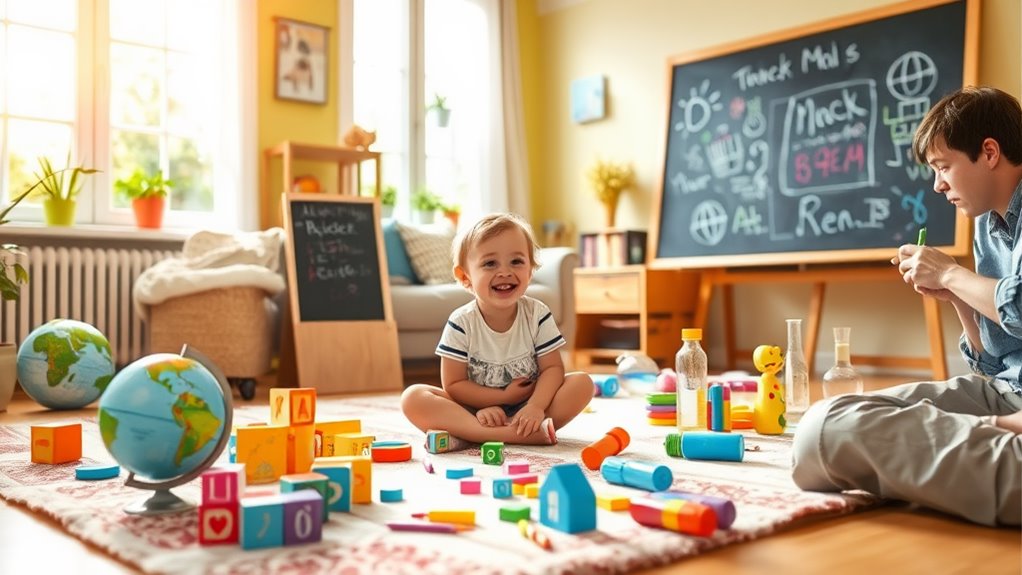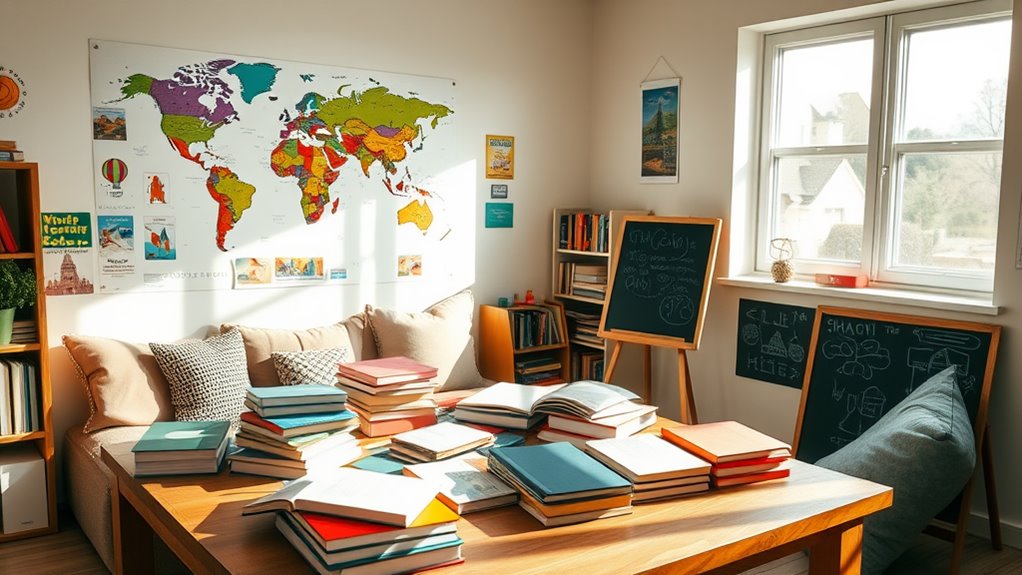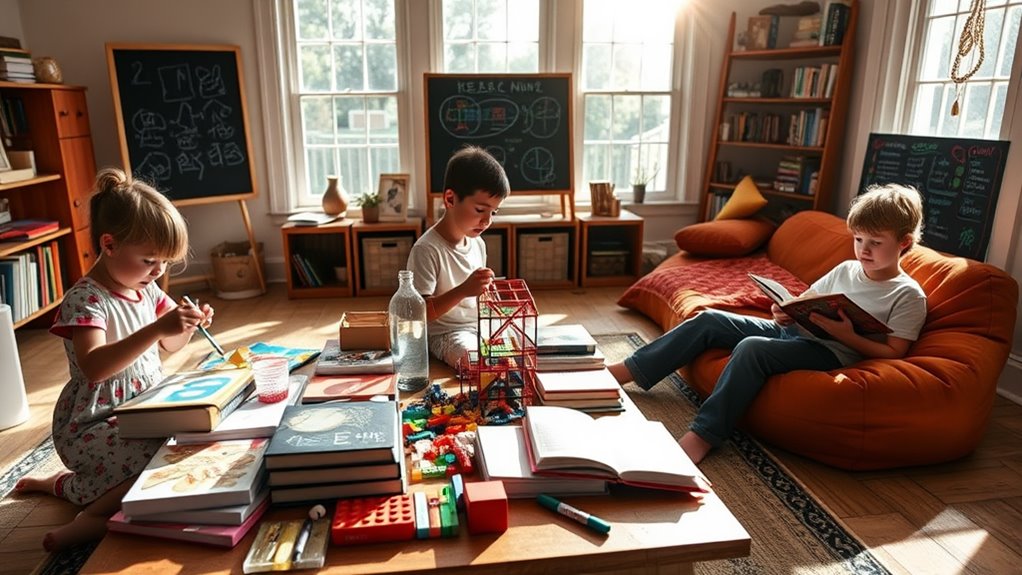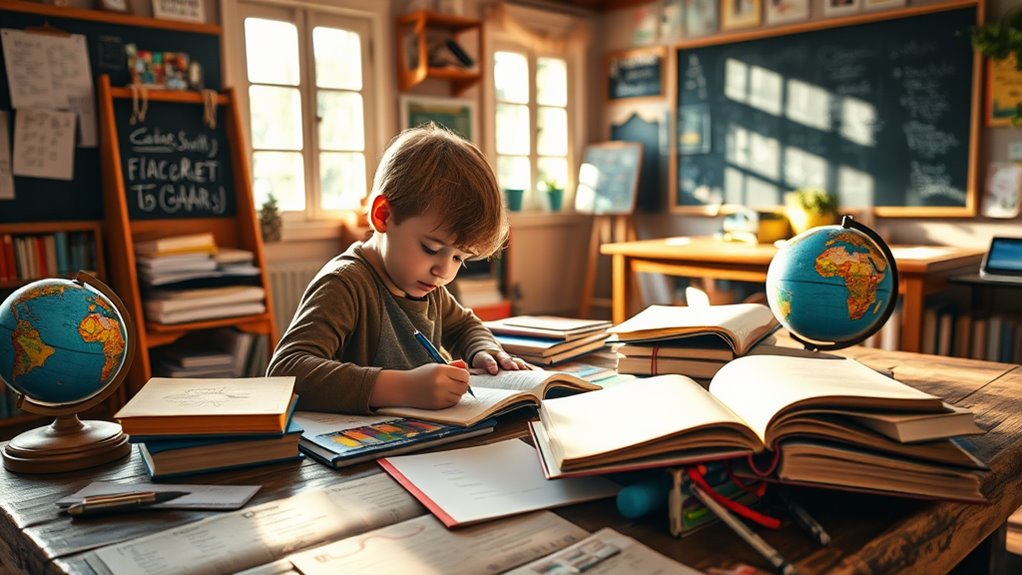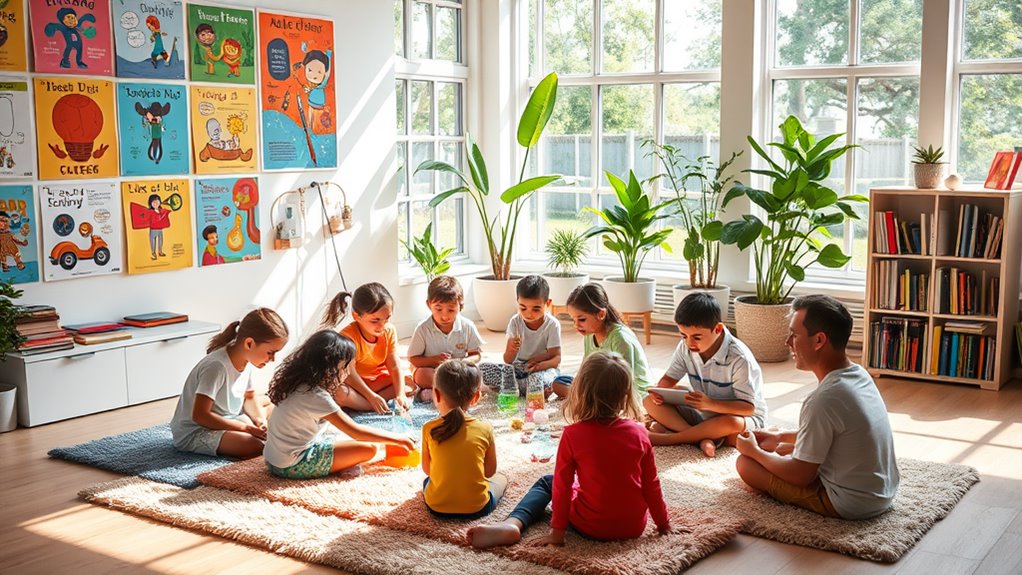How to Make Learning Fun for Kids at Home
To make learning fun for your kids at home, try mixing in interactive activities like hands-on experiments and creative technology use. Incorporate educational games that build critical thinking skills while keeping it enjoyable. Themed learning days can turn ordinary lessons into exciting adventures, complete with crafts and snacks. Don’t forget outdoor experiences; nature scavenger hunts and experiments can spark curiosity and keep learning engaging. By creating a dynamic and immersive environment, you’ll inspire a love for learning. There are plenty more ideas to explore that can keep your kids excited and eager to learn even more.
Key Takeaways
- Incorporate hands-on experiments like baking soda and vinegar reactions to engage children’s curiosity and illustrate concepts in a fun way.
- Use creative technology tools, such as virtual reality and coding projects, to make learning interactive and develop essential skills.
- Introduce educational games and puzzles that blend fun with critical thinking, enhancing vocabulary and problem-solving abilities.
- Organize themed learning days with crafts, snacks, and activities centered around topics of interest to create memorable educational experiences.
- Plan outdoor learning activities, such as nature scavenger hunts, to provide real-world experiences that make science and exploration tangible for children.
Interactive Learning Activities
Interactive learning activities are a fantastic way to engage kids in the learning process while keeping them entertained. Instead of traditional lectures, you can introduce hands-on experiments that spark curiosity. Imagine your child mixing baking soda and vinegar to create a mini volcano; it’s not just fun, but they’ll also learn about chemical reactions in a memorable way.
You can also incorporate storytelling sessions that bring learning to life. Choose a theme, like space or dinosaurs, and let your child dive into an imaginative world. Encourage them to create their own stories based on what they’ve learned. This not only boosts their creativity but reinforces their understanding of the subject matter.
Don’t forget to mix it up! Alternate between hands-on experiments and storytelling to cater to different learning styles. By doing so, you’ll create a dynamic learning environment that keeps your child engaged and eager to learn.
The key is to keep activities interactive and enjoyable, allowing your child to explore and discover at their own pace. Remember, learning doesn’t have to be a chore; with the right activities, it can be an adventure!
Creative Use of Technology
Many parents find that incorporating technology into learning can make the process more engaging for kids. One exciting option is virtual reality (VR). By using a VR headset, your child can explore ancient civilizations, dive into the ocean, or even travel through space—all from the comfort of home. This immersive experience can spark curiosity and enhance understanding of complex subjects.
Another great way to use technology creatively is through coding projects. There are numerous platforms and apps designed to teach kids the basics of coding in a fun and interactive way. You can help your child create their own games or animations, which not only boosts their tech skills but also encourages problem-solving and critical thinking.
Consider setting up a weekly tech time where you explore different coding projects together. This can turn learning into a collaborative adventure, making it more enjoyable for both of you.
Plus, it helps your child develop essential skills for the future. By creatively using technology like VR and coding, you can transform learning into an exciting journey that keeps your child engaged and eager to learn more.
Educational Games and Puzzles
Incorporating educational games and puzzles into your child’s learning routine can further enhance their engagement and enjoyment. Board games are a fantastic way to combine fun with learning. Look for games that encourage critical thinking, strategy, and teamwork. Games like Scrabble or Monopoly not only entertain but also help build vocabulary and math skills.
You can turn game night into an educational experience without your child even realizing it!
Puzzle challenges offer another exciting avenue for learning. Whether it’s jigsaw puzzles or brain teasers, these activities stimulate problem-solving skills and improve concentration. Choose puzzles that are age-appropriate and gradually increase the difficulty to keep your
Themed Learning Days
Creating themed learning days can transform your child’s education into an exciting adventure. You can choose a theme that sparks their interest—like space, dinosaurs, or even their favorite book.
Start the day with themed crafts that relate to the topic. For instance, if you pick space, create rocket ships from cardboard or paint planets. These hands-on activities make learning more engaging and memorable.
Next, you can integrate themed snacks that tie into your chosen theme. For example, you could make “moon rocks” by coating grapes in powdered sugar or create dinosaur-shaped sandwiches with cookie cutters. This not only makes lunchtime fun but also reinforces the theme and creates a holistic learning experience.
Throughout the day, weave in educational activities related to the theme. You might read books, watch documentaries, or conduct science experiments. The key is to keep the energy up and encourage curiosity.
Outdoor Learning Experiences
After enjoying themed learning days, consider taking education outside to experience nature firsthand. Outdoor learning experiences can be incredibly engaging and memorable for your kids.
Start with a nature scavenger hunt, where you create a list of items for them to find, like different types of leaves, rocks, or flowers. This activity encourages observation and exploration while allowing them to connect with their environment.
You can also conduct outdoor experiments that make science come alive. For instance, collect soil samples and examine them under a magnifying glass, or create a simple weather station using a thermometer and rain gauge. These hands-on activities not only make learning fun but also help your children grasp complex concepts through real-world applications.
Don’t forget to incorporate storytelling or drawing sessions based on their findings. Encourage them to sketch what they discover or write a short tale about their adventure.
Encouraging Curiosity and Questions
To spark a child’s natural curiosity, it’s essential to foster an environment where questions are encouraged and celebrated. When kids feel safe to ask, they’re more likely to explore new ideas and concepts.
Make it a point to respond positively to their inquiries, no matter how simple or complex. This support can ignite their imagination and creativity.
One effective strategy is to use question prompts. Instead of providing straight answers, encourage them to dig deeper by asking, “What do you think?” or “How could we find out?”
These prompts can help them develop critical thinking skills while fueling their curiosity.
You can also create opportunities for hands-on experiences that naturally lead to questions. For instance, while cooking, ask, “What happens when we mix these ingredients?”
Or during a nature walk, point out something unusual and say, “Why do you think that plant grows here?”
Frequently Asked Questions
How Can I Balance Learning and Playtime Effectively?
You can balance learning and playtime effectively by creating creative schedules that incorporate interactive games. This way, learning feels less like a chore and more like an enjoyable experience, keeping kids engaged and motivated.
What Age-Appropriate Activities Are Best for Toddlers?
For toddlers, engaging in sensory play and interactive storytelling works wonders. You can create colorful sensory bins or use puppets during storytelling to spark their imagination, helping them learn while having a blast.
How Can I Encourage Sibling Collaboration in Learning?
Encouraging sibling collaboration in learning’s like planting seeds in a garden; with the right care, they’ll flourish. Try joint projects or learning games that require teamwork, fostering cooperation and creativity while making learning enjoyable together.
What Are Some Inexpensive Materials for Home Learning?
You can use craft supplies like paper, glue, and scissors alongside household items such as cardboard boxes and old magazines. These materials can spark creativity and support various learning activities, making education both engaging and affordable.
How Do I Assess My Child’s Learning Progress at Home?
To assess your child’s learning progress at home, establish clear learning milestones and use progress tracking tools like checklists or charts. Regularly review their achievements to adjust your approach and celebrate their successes.

